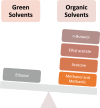A systematic review on natural products with antimicrobial potential against WHO's priority pathogens
- PMID: 40597250
- PMCID: PMC12211454
- DOI: 10.1186/s40001-025-02717-x
A systematic review on natural products with antimicrobial potential against WHO's priority pathogens
Abstract
Background: Antimicrobial resistance (AMR) is a critical global issue, with bacteria increasingly resistant to traditional antibiotics, resulting in more treatment failures and higher mortality rates. Resistance can be defined microbiologically or clinically and arises through genetic mutations or acquired traits. In response to this growing threat, the World Health Organization (WHO) established a priority list of antibiotic-resistant bacteria in 2016 to guide the research and development of new antimicrobial agents. The COVID-19 pandemic has further exacerbated AMR, underscoring the urgent need for new antibiotics. Natural products continue to be a valuable source of antibacterial compounds and play a significant role in developing new antimicrobial treatments.
Method: This study employed a systematic review methodology, conducting comprehensive searches across PUBMED/MEDLINE, WEB OF SCIENCE, and SCOPUS databases, adhering to modified PRISMA-ScR reporting guidelines. A research librarian assisted in developing the search strategy, with searches executed on May 5, 2024, without restrictions on publication dates.
Study selection process: Titles and abstracts were screened using Rayyan and Endnote. Inclusion criteria focused on original studies examining the antimicrobial effects of natural products against antibiotic-resistant pathogens, including risk estimates with 95% confidence intervals. The review identified significant effects of natural products on 12 families of antibiotic-resistant bacteria as reported by the World Health Organization (WHO). These findings underscore the potential of natural compounds as therapeutic agents in combating antimicrobial resistance.
Results: A total of 4371 articles published between 2014 and 2024 were initially identified, from which 290 articles were selected for detailed review based on their relevance to the study period. All included studies were clinical trials. The analysis indicated that most of the research on dietary plants was conducted in countries within the Middle East, South America, and Africa. Among the pathogens investigated, Pseudomonas aeruginosa, Escherichia coli, Klebsiella pneumoniae, Salmonella typhi, and Staphylococcus aureus emerged as the most frequently studied due to their involvement in a wide range of infectious diseases. The findings revealed that alkaloids, flavonoids, phenols, saponins, tannins, and terpenoids were the principal classes of plant-derived compounds exhibiting antioxidant activity against bacterial strains. These bioactive compounds were extracted using a variety of solvents, including ethanol, methanol, aqueous solutions, benzoate, ethyl acetate, n-butanol, and methanolic preparations obtained from different plant parts such as leaves, bark, flowers, and roots. Notably, flavonoids represented 24.8% of the antioxidant product derivatives examined. The overall results underscore the significant therapeutic potential of regional medicinal plants in combating pathogens resistant to chemical drugs. Their antioxidant and cytotoxic properties may enhance the efficacy of existing antibiotic classes and contribute to reversing antimicrobial resistance.
Conclusion: Based on the findings of this review, the diverse effects and therapeutic efficacy of herbal compounds in managing antibiotic resistance were extensively examined. Consequently, in light of the demonstrated antimicrobial activities of these plant-derived compounds, further investigation into their potential as alternative agents to counteract antibiotic resistance has become increasingly essential.
Keywords: Antibacterial agents; Antimicrobial; MDR; Multidrug resistant; Natural product; Plant extracts; Anti-Infective Agents.
© 2025. The Author(s).
Conflict of interest statement
Declarations. Ethics approval and consent to participate: Not applicable. Consent for publication: Not applicable. Competing interests: The authors declare no competing interests.
Figures






Similar articles
-
A rapid and systematic review of the clinical effectiveness and cost-effectiveness of topotecan for ovarian cancer.Health Technol Assess. 2001;5(28):1-110. doi: 10.3310/hta5280. Health Technol Assess. 2001. PMID: 11701100
-
Drugs for preventing postoperative nausea and vomiting in adults after general anaesthesia: a network meta-analysis.Cochrane Database Syst Rev. 2020 Oct 19;10(10):CD012859. doi: 10.1002/14651858.CD012859.pub2. Cochrane Database Syst Rev. 2020. PMID: 33075160 Free PMC article.
-
Global antimicrobial resistance and antibiotic use in COVID-19 patients within health facilities: A systematic review and meta-analysis of aggregated participant data.J Infect. 2024 Jul;89(1):106183. doi: 10.1016/j.jinf.2024.106183. Epub 2024 May 14. J Infect. 2024. PMID: 38754635
-
Systemic pharmacological treatments for chronic plaque psoriasis: a network meta-analysis.Cochrane Database Syst Rev. 2021 Apr 19;4(4):CD011535. doi: 10.1002/14651858.CD011535.pub4. Cochrane Database Syst Rev. 2021. Update in: Cochrane Database Syst Rev. 2022 May 23;5:CD011535. doi: 10.1002/14651858.CD011535.pub5. PMID: 33871055 Free PMC article. Updated.
-
Prognosis of adults and children following a first unprovoked seizure.Cochrane Database Syst Rev. 2023 Jan 23;1(1):CD013847. doi: 10.1002/14651858.CD013847.pub2. Cochrane Database Syst Rev. 2023. PMID: 36688481 Free PMC article.
References
-
- Frieri M, Kumar K, Boutin A. Antibiotic resistance. J Infect Public Health. 2017;10(4):369–78. - PubMed
-
- MacGowan A, Macnaughton E. Antibiotic resistance. Medicine. 2017;45(10):622–8.
-
- MacGowan AP. Clinical implications of antimicrobial resistance for therapy. J Antimicrob Chemother. 2008;62(suppl_2):ii105-ii14. - PubMed
-
- UN UA. Global leaders commit to act on antimicrobial resistance. Collective effort to address a challenge to health, food security, and development, 2016. 2018. https://www.who.int/news/item/21-09-2016-at-un-global-leaders-commit-to-....
-
- Organization WH. WHO bacterial priority pathogens list, 2024: bacterial pathogens of public health importance, to guide research, development, and strategies to prevent and control antimicrobial resistance: World Health Organization; 2024. https://www.who.int/publications/i/item/9789240093461.
Publication types
MeSH terms
Substances
LinkOut - more resources
Full Text Sources
Medical
Research Materials

